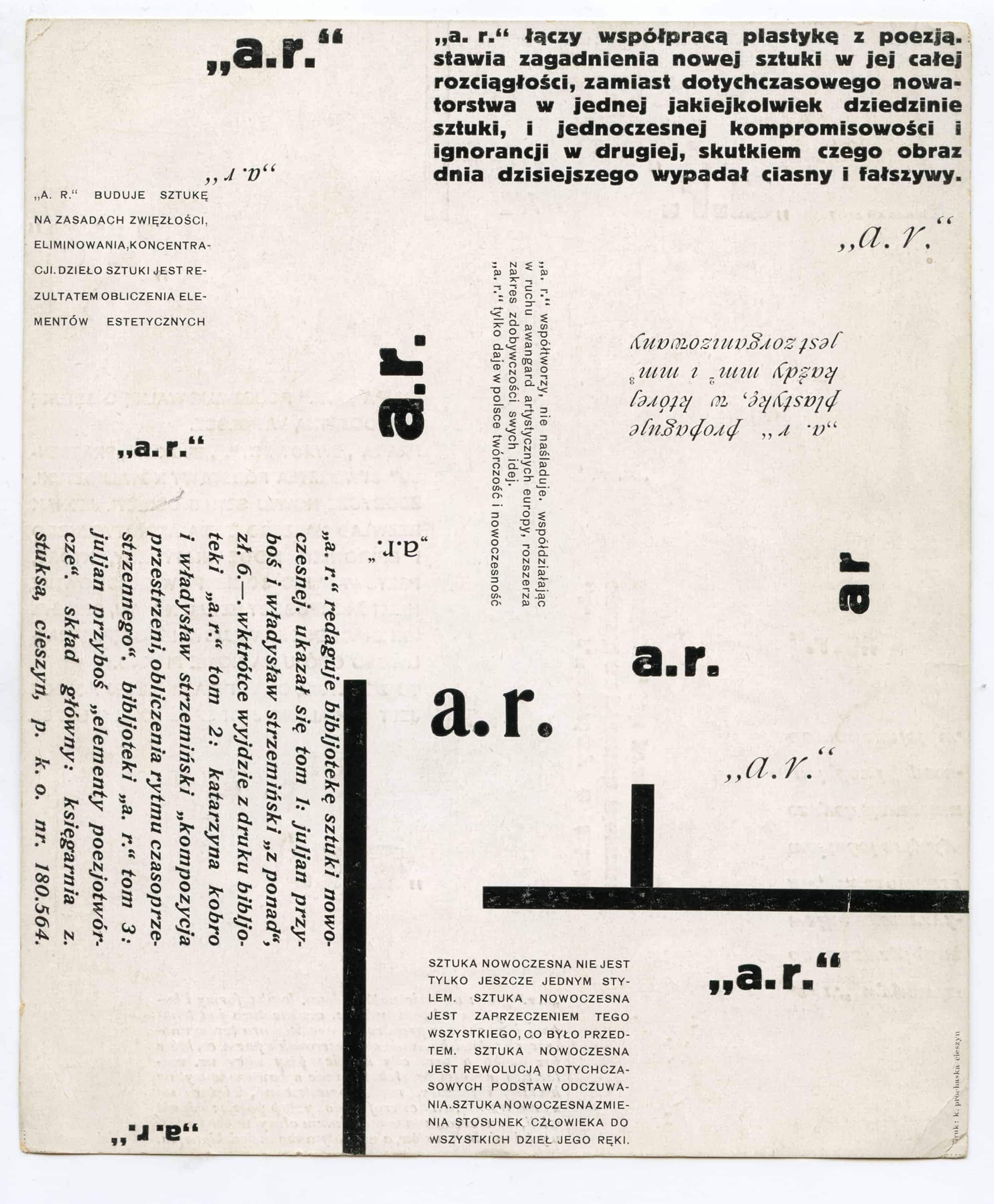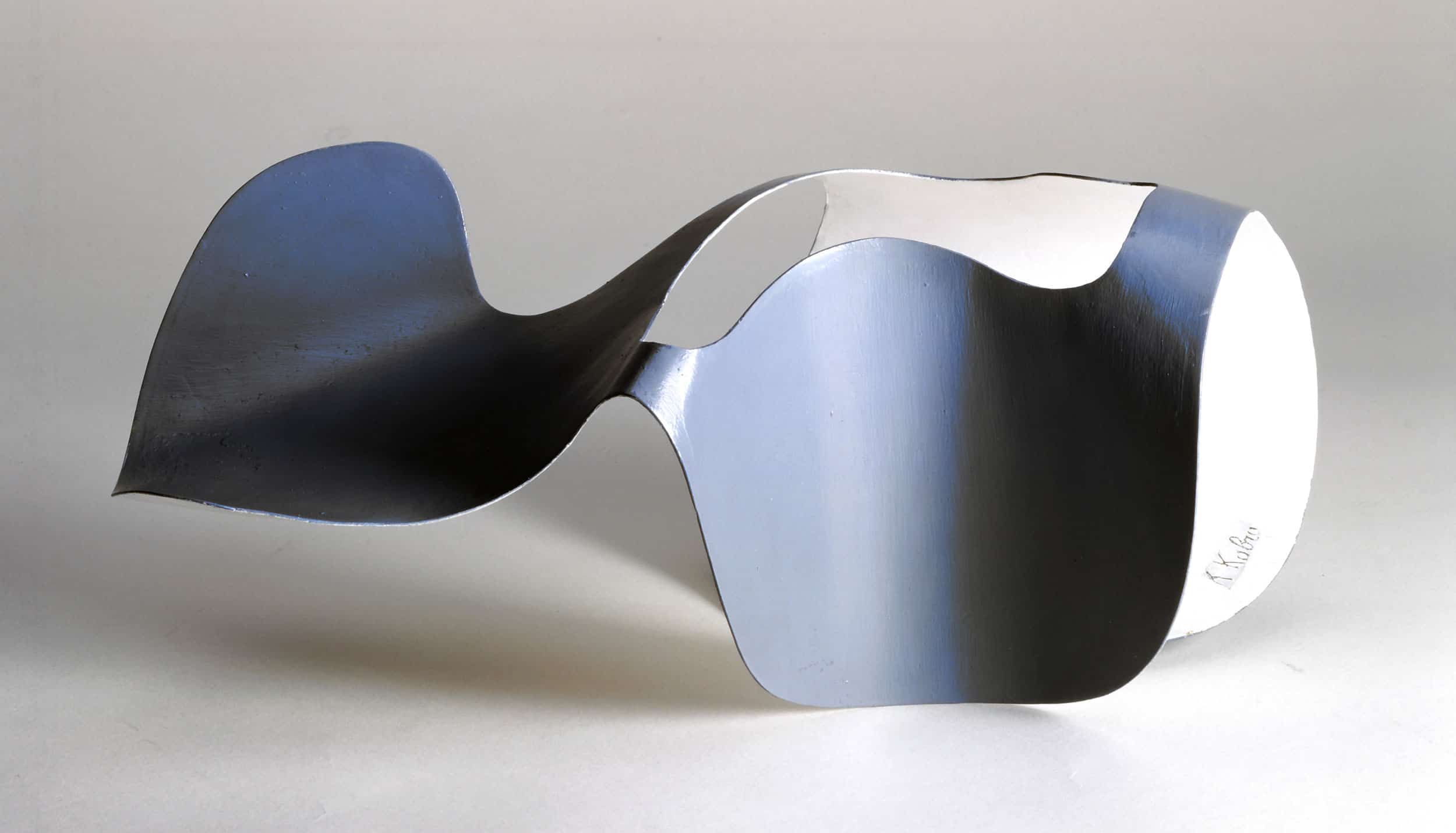A couple of modernist artists, Katarzyna Kobro and Władysław Strzemiński, got married in the year 1920. They were planning to move immediately to Paris hailed as the capital of the pre-war avant-garde movement. Their leave didn’t pan out due to the accusations of spying for the Russians levelled at them as soon as they crossed the Polish border.

J. Przybos, W. Strzeminski, K. Kobro, vers 1930 © Archive Muzeum Sztuki, Lodz
Kobro and Strzemiński’s fervent dream of “the great European tour” came to fruition almost a century later: from the impressive retrospective at the Museo Reina Sofía in Madrid, through the exhibition at the Moderna Museet in Malmö, Sweden, to the iconic Centre Pompidou in their beloved Paris. However, those are by no means the first avant-garde artists from Poland whose works are put on display in the world-famous institution of culture and thus reclaim their rightful place in the contemporary art history, adjusting its course, bridging the perennial divide between the East and the West. The likes of Andrzej Wróblewski and Alina Szapocznikow have followed the same path not long before Kobro and Strzeminśki. Preceded by an exhibit entitled “The Russian Avant-garde at Vitebsk (1918-1922),” the Kobro-Strzemiński art show in the Centre Pompidou is organised as part of the museum’s policy to accommodate the artists representing the “non-Western” tradition.

Katarzyna Kobro, Spatial Composition 4, 1929, steel, painted, coloured, 40 x 64 x 40 cm, photo: courtesy of Muzeum Sztuki in Łódź
The Adam Mickiewicz Institute and Muzeum Sztuki in Łódź are the official partners of the monographic exhibition in Paris. In fact, Jarosław Suchan – co-curator and director of an art museum in Łódź – could be deemed the successor to Kobro and Strzemiński who were the first to govern this very institution in the 1930s. To this day, the national and global legacy of the avant-garde is cultivated in their astonishing neo-plastic room. Nevertheless, their international reputation was inarguably boosted by the film “Powidoki” (“Afterimage”). The cinematic swansong by Andrzej Wajda was screened during multiple film festivals and reacquainted the audience with the life story of the artist who developed his “Theory of Vision”. Furthermore, paramount to the exhibition is the catalogue in French and English that was issued by Skira, a prestigious publishing press.

Wladyslaw Strzeminski, Projekt lady wystawienniczej z cyklu Projekty wystawiennicze (Projet de présentoir cycle Projets d’expositions) ca. 1946 – 1948 Muzeum Sztuki, Lodz ©Muzeum Sztuki, Lodz & Ewa Sapka-Pawliczak
The exhibition of a Polish avant-garde covers the entire 4th floor of the Centre Pompidou. An austere arrangement brings out the details of each work on display that includes around 180 pieces created not only by Kobro and Strzemiński but also other artists such as Jean Arp, Stanisław Grabowski, Karol Hiller, Fernand Leger, Kurt Schwitters, Henryk Stażewski and Mieczysław Szczuka. Their works provide the viewer with a bigger picture and successfully complement the show. This artistic circle might as well be expanded to encompass entire Europe, since both Kobro and Strzemiński forged close relations with the Russian Constructivists, De Stijl group and the Paris-based Cercle et Carré.

Wladyslaw Strzeminski (projet graphique) Komunikat grupy „a.r.” no. 1 (Communiqué du groupe „a.r.” no 1) Cieszyn 1930, Archive of Muzeum Sztuki, Lodz ©Muzeum Sztuki, Lodz & Ewa Sapka-Pawliczak
The curators opt for a chronological division of the exhibition into six subsequent stages corresponding with the evolution of the artists’ ideas. The narrative is set in motion in the early days of their artistic career that oscillates between Moscow and their friendship with Malevich or Tatlin. Kobro was born in Russia and never quite managed to feel at home in Poland. The next room is devoted in its entirety to the theory of unism espoused by Strzemiński and encapsulated by Kobro’s sculptures. In painting, the main principle of unism was to accentuate a flat monochrome surface with an open composition and sublime texture. In addition, the art show demonstrates a social engagement of both artists who imbued their art with revolutionary potential, especially as the members of Praesens and a.r., groups. This part of the exhibit bears testimony to the collection of modern art they put together and unveiled in Łódź back in 1931. The room entitled “Design at the Service of Utopia” embodies Kobro and Strzemiński’s perception of art as an all-encompassing discipline, which drew on Gesamtkunstwerk and utilitarian art. Here, you can view their products of industrial design, including urban planning, architecture, furniture, pamphlets, book covers and tapestry. The rest of the exposition focuses on Strzemiński’s oeuvre, his meditation on the theory of vision and especially the pieces he made after the Second World War. For instance, all the works in the series “To my Jewish Friends” (“Moim Przyjaciołom Żydom”), which were bestowed upon the Yad Vashem Center in Jerusalem, were drawn in ink on the white, grey and beige sheets of paper. In this series of collages, abstract forms portrayed, e.g. in the film “Afterimages” are juxtaposed against the cut-outs of photographs featuring the anonymous victims of the Holocaust, transport and deportation. This representation of the horrors of war is placed side by side with Kobro’s nudes created in the spirit of Cubism, which marked the artist’s late departure from the abstract “spatial compositions” around the year 1948.

Katarzyna Kobro, Kompozycja przestrzenna (9) (Composition spatiale (9)) ca. 1933 Muzeum Sztuki, Lodz ©Muzeum Sztuki, Lodz & Ewa Sapka-Pawliczak
All in all, the exhibit comprises some of the most dazzling gems in the private and public art collections, most notably the one boasted by the Muzeum Sztuki in Łódź: “afterimages” on large-scale canvas, “unistic compositions” by Strzemiński and “spatial compositions” by Kobro, the latter of whom did also create the famous suspended sculptures. In case of the Paris show, these rarely exhibited pieces, emanate with a captivating beauty due to the cascading lights. It seems worth pointing out that all the works ever produced by this pair of modernist artists are now scarce, incredibly valuable and thus highly coveted items. An abundance of their pieces was simply lost or obliterated in the tumultuous aftermath of the war, their frequent relocation, poverty and destitution they faced in post-war Poland. Their daughter Nika gave a harrowing account of Kobro burning her wooden sculptures in the tiled stove.

Wladyslaw Strzeminski Kompozycja unistyczna 14 Composition uniste 14 1934 Muzeum Sztuki, Lodz ©Muzeum Sztuki, Lodz & Ewa Sapka-Pawliczak
The exhibition at the Centre Pompidou presents the Kobro-Strzemiński tandem as equal partners in life, art and interpersonal relations, even though Kobro had spent most of her life in the shadow of a more famous husband. Nowadays, female avant-garde artists finally gain the recognition they deserve owing to the studies in art history influenced by the postulates of the critical feminist thought. An exponential amount of research is conducted currently on the modernists’ relationships, ties and connections between the artists and their male or female partners. This subject is addressed for instance by the staggering art show entitled “Modern Couples. Art, Intimacy and the Avant-garde” that opened at the Barbican Centre in London.

Wladyslaw Strzeminski Powidok swiatła. Kobieta w oknie Rémanence lumineuse. Une femme à la fenêtre ca. 1948 Muzeum Sztuki, Lodz ©Muzeum Sztuki, Lodz & Ewa Sapka-Pawliczak
Beyond the shadow of a doubt, an exhibition dedicated to the works of Kobro and Strzemiński is the momentous celebration of Polish art that will go down in history. However, it also serves as an ideal occasion to pose some questions. Will the exhibition resonate with the Paris audience? Could the reception of those works of art from the country behind the Iron Curtain be tainted by its historical and political connotations? Will the spectators notice how Kobro and Strzemiński imbibe and elaborate on the worldview cherished by the Paris-based avant-garde artists of the interwar period or will they choose to follow the interpretative framework of the Russian Constructivism and the group of artists associated with Malevich? Who knows? Perhaps this pair of radical visionaries, “the architects of the world” if you will (to borrow the title of Andrzej Turowski’s book) will be appreciated by the Paris audience as those who conjured up great ideas in the times of great turbulence.

Katarzyna Kobro and Wladyslaw Strzeminski, Wisła (Poland), 1933, Muzeum Sztuki, Lodz
Edited by Contemporary Lynx








